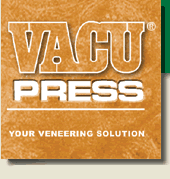| | |
Peter Ness

|
Hello Everyone,Darryl gave me some great advice about veneering a curve (previous post) so I thought I would share some of my non press veneer experience re: contact cement and leather.I have had good results applying garment weight leather and suede to plywood using water based contact cement - which is nice since it is easy and non toxic. I really heavily applied the cement to the leather and the wood and then rubbed down with a roller or burnisher. I have also applied it to carvings ( about 1" deep max) using a brush and doing small areas at a time, then burnishing. The latex base contact cement was very forgiving and thinner leathers are so stretchy it was easy to get good detail. "pull up" leathers - the kind that lighten in color when pulled work really nice - they add dimension to the carving.Because the back of the leather is so porous it adhered very well - I have had the cabinet 5 years in a very alternately moist/dry non climate controlled environment and there is no delamination.I wouldn't recommend this for tabletops or anything but it worked very well for plywood cabinet sides - applied only two one side with no warping. I think because both the glue line and the leather are so flexible.I know you can purchase very thin desktop leather from vandykes and similar places, but I prefer to use heavier leather purchased from garment/upholstery stores due to the greater finish choices and cost Ebay also has some great ones sometime. Fishmans fabrics in Chicago has some great oddlot leather hides for very little a square foot (sometimes $2 or less)- they are leftover hides but you can get enough from a hide for a medium cabinet or dresser.This might be a good solution if you have a real problem area on a piece where you want a quick and dirty fix. I really like my cabinet because the leather has a slight give to it which makes it nice to the touch and the leather has a nice antiqued deep red finish that comes very close to the bloodwood wood parts.
|
|





